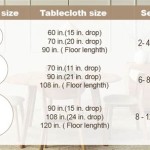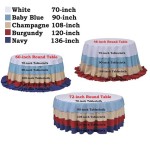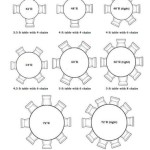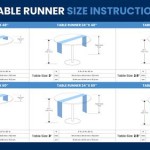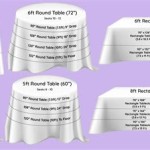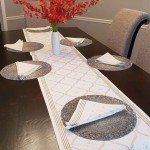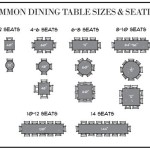Space Needed For Round Dining Table: A Comprehensive Guide
Selecting the right dining table involves more than just aesthetics; understanding the spatial requirements is paramount. A round dining table, while offering a visually appealing and sociable dining experience, necessitates careful consideration of the surrounding space to ensure comfortable movement and prevent a cramped atmosphere. This article explores the factors influencing the space needed for a round dining table, providing guidance on how to determine the ideal size and placement for optimal functionality and ambiance.
The allure of a round dining table lies in its ability to foster intimate conversations. Its circular shape eliminates the traditional head of the table, creating a more egalitarian setting where everyone can easily see and interact with each other. This makes it a popular choice for smaller gatherings and informal dining spaces. However, the inherent circular footprint introduces unique spatial considerations that need to be addressed before making a purchase.
The diameter of the round table is the primary determinant of its spatial requirements. A larger diameter accommodates more guests but also demands a larger room. Conversely, a smaller diameter might be suitable for a compact space but may feel restrictive when hosting larger groups. The key is to find a balance between seating capacity and available space, ensuring a comfortable and functional dining area.
Determining Minimum Room Size
Calculating the minimum room size required for a round dining table goes beyond simply measuring the table's diameter. It involves accounting for the necessary clearance around the table to allow for comfortable seating, movement, and access to other areas of the room. A general guideline suggests allowing at least 36 inches (3 feet) between the edge of the table and any wall or furniture. This buffer zone, often referred to as the "walkway space," ensures that people can easily pull out chairs, sit down, and move around the table without bumping into obstacles.
Therefore, to determine the minimum room size, add 72 inches (6 feet) to the table's diameter. For example, a 48-inch round table requires a room that is at least 120 inches (10 feet) in width and length to accommodate comfortable seating and movement. This calculation provides a baseline, and adjustments may be necessary depending on the specific layout of the room and the presence of other furniture.
If the room also includes furniture such as a buffet, china cabinet, or sideboard, the walkway space needs to be adjusted accordingly. These pieces of furniture will further reduce the available space, potentially impacting the overall functionality of the dining area. In such cases, consider rearranging the furniture to maximize the available space around the table or opting for a smaller table to maintain adequate clearance.
Consider the placement of doorways and walkways leading into the dining area. Ensure that the table does not obstruct these pathways, as this can create a bottleneck and make it difficult to navigate the space. Ideally, the table should be positioned so that it is easily accessible from all entrances and exits, allowing for smooth traffic flow.
The shape of the room also plays a role in determining the optimal size of the round dining table. In square or rectangular rooms, a round table can create a visual contrast and soften the angular lines. However, in narrow or oddly shaped rooms, a round table might not be the most efficient use of space. In these situations, consider alternative table shapes, such as oval or rectangular, which might better conform to the room's dimensions.
Accounting for Seating Capacity
The number of people you typically host for meals is another crucial factor to consider when selecting the size of a round dining table. While a smaller table might suffice for everyday meals with family, it might not be adequate for larger gatherings. It is essential to choose a table that comfortably accommodates your usual number of guests without feeling cramped.
As a general rule, allow approximately 24 inches of width per person around the table. This provides sufficient elbow room and prevents diners from feeling crowded. Therefore, a 48-inch round table can comfortably seat four people, while a 60-inch table can accommodate six. Larger tables, such as those with a 72-inch diameter, can seat eight or more people, but they also require significantly more space.
Consider purchasing a round dining table with leaves or extensions. These tables offer the flexibility to expand the seating capacity when needed for larger gatherings while maintaining a smaller footprint for everyday use. A round table with leaves can be a practical solution for those who frequently host guests but have limited space.
The type of chairs used around the table can also influence the overall space requirements. Chairs with arms typically require more space than those without arms. Additionally, the depth of the chair and the amount of space needed to pull it out from the table should be factored into the calculation. Consider using chairs that are appropriately sized for the table and the room.
When determining the seating capacity, also consider the comfort of the diners. While it might be possible to squeeze more people around a small table, it can lead to an uncomfortable dining experience. Prioritize comfort and space when making your decision, ensuring that everyone has enough room to move and enjoy their meal.
Considerations for Room Ambiance and Style
Beyond the objective measurements of space and seating capacity, the aesthetic impact of a round dining table on the room's ambiance and style should not be overlooked. A round table can create a more relaxed and intimate atmosphere, encouraging conversation and fostering a sense of connection among diners. However, the choice of table size and style should be in harmony with the overall design of the room.
A large round table in a small room can overwhelm the space, making it feel cramped and unbalanced. Conversely, a small table in a large room can appear insignificant and create a feeling of emptiness. Strive for a proportional balance between the table size and the room's dimensions, ensuring that the table complements the overall design rather than dominating it.
The style of the round dining table should also be consistent with the overall aesthetic of the room. A modern, minimalist dining room might be best suited for a simple, streamlined round table with clean lines. A more traditional dining room might benefit from a round table with ornate details and a classic finish. The choice of materials, such as wood, glass, or metal, can also influence the overall look and feel of the dining area.
Consider the lighting in the dining area when selecting a round dining table. A well-placed chandelier or pendant light can accentuate the shape of the table and create a focal point in the room. The height of the lighting fixture should be appropriate for the table size and ceiling height, ensuring that it illuminates the table without obstructing the view.
The color scheme of the dining area can also influence the perceived size of the space. Light and airy colors can make a room feel larger and more open, while dark colors can create a more intimate and cozy atmosphere. Consider using light-colored walls and furniture to maximize the perceived space around the round dining table.
In conclusion, selecting the right round dining table involves a comprehensive assessment of the available space, seating requirements, and aesthetic considerations. By carefully considering these factors, one can create a dining area that is both functional and visually appealing, providing a comfortable and inviting space for meals and gatherings.

Dining Room Size Round Table Circular Open

Dining Room Guide How To Maximize Your Layout

How To Calculate The Best Dining Table Size For Your Room

Dining Room Size

Selected Furniture Tables And Seating Guide

Rules Of Thumb For Rugs Under Round Dining Tables Inspiration

How To Build A 70 Round Dining Table Honey Built Home

Round Table Seating Guide Diy Kitchen Dining Room

Extending Round Rustic Modern Space Saving Dining Table The Grain Company Ltd

A Guide To Choosing The Ideal Dining Table Width
Related Posts

